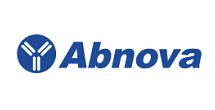FGF10 monoclonal antibody (M05), clone 3C7



* The price is valid only in USA. Please select country.
-
More Files
- More Functions
-
Specification
Product Description
Mouse monoclonal antibody raised against a partial recombinant FGF10.
Immunogen
FGF10 (NP_004456, 38 a.a. ~ 137 a.a) partial recombinant protein with GST tag. MW of the GST tag alone is 26 KDa.
Sequence
QALGQDMVSPEATNSSSSSFSSPSSAGRHVRSYNHLQGDVRWRKLFSFTKYFLKIEKNGKVSGTKKENCPYSILEITSVEIGVVAVKAINSNYYLAMNKK
Host
Mouse
Reactivity
Human
Isotype
IgG2a Kappa
Quality Control Testing
Antibody Reactive Against Recombinant Protein.
Western Blot detection against Immunogen (36.74 KDa) .
Storage Buffer
In 1x PBS, pH 7.4
Storage Instruction
Store at -20°C or lower. Aliquot to avoid repeated freezing and thawing.
-
Applications
Western Blot (Recombinant protein)
ELISA
In situ Proximity Ligation Assay (Cell)
Proximity Ligation Analysis of protein-protein interactions between FGFR2 and FGF10. HeLa cells were stained with anti-FGFR2 rabbit purified polyclonal 1:1200 and anti-FGF10 mouse monoclonal antibody 1:50. Each red dot represents the detection of protein-protein interaction complex, and nuclei were counterstained with DAPI (blue). -
Gene Info — FGF10
Entrez GeneID
2255GeneBank Accession#
NM_004465Protein Accession#
NP_004456Gene Name
FGF10
Gene Alias
-
Gene Description
fibroblast growth factor 10
Gene Ontology
HyperlinkGene Summary
The protein encoded by this gene is a member of the fibroblast growth factor (FGF) family. FGF family members possess broad mitogenic and cell survival activities, and are involved in a variety of biological processes, including embryonic development, cell growth, morphogenesis, tissue repair, tumor growth and invasion. This protein exhibits mitogenic activity for keratinizing epidermal cells, but essentially no activity for fibroblasts, which is similar to the biological activity of FGF7. Studies of the mouse homolog of suggested that this gene is required for embryonic epidermal morphogenesis including brain development, lung morphogenesis, and initiation of lim bud formation. This gene is also implicated to be a primary factor in the process of wound healing. [provided by RefSeq
Other Designations
keratinocyte growth factor 2|produced by fibroblasts of urinary bladder lamina propria
-
Interactome
-
Pathway
-
Disease
- +1-909-264-1399
+1-909-992-0619
Toll Free : +1-877-853-6098 - +1-909-992-3401
- sales@abnova.com












